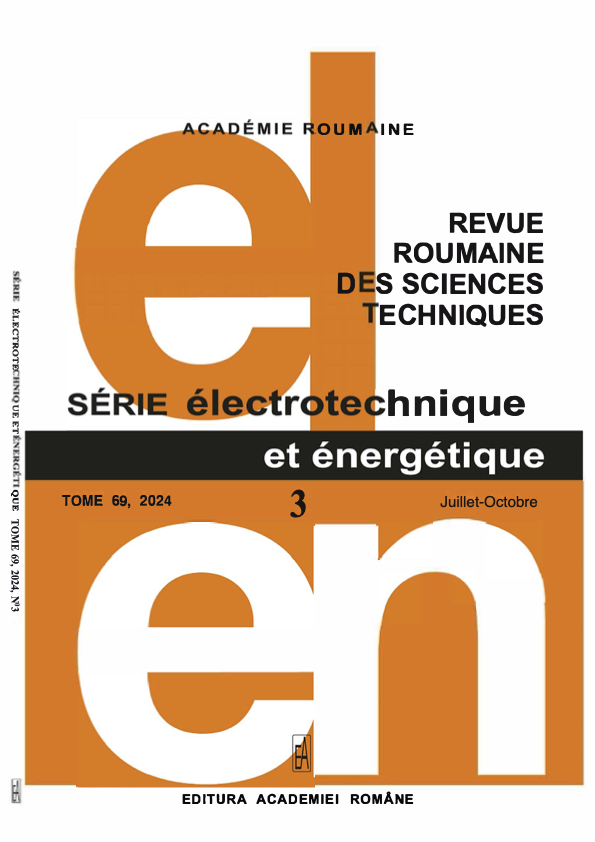LES EFFETS DU CONTRÔLE D'APPRENTISSAGE DU MODE COULISSANT HYBRIDE ET DU CONTRÔLEUR DE DROP FORWARD AVEC GAIN DE DROP ÉLEVÉ DANS UN MICRO-RÉSEAU HYBRIDE AVEC INCERTITUDE DE CHARGE ET NON-LINÉARITÉ
DOI :
https://doi.org/10.59277/RRST-EE.2024.69.3.3Mots-clés :
Opération insulaire, Chute d'angle, Filtre LCL, Contrôleur de mode glissant hybride (HSMC), Gain de statisme élevéRésumé
La présente étude propose une stratégie de statisme d'angle à action directe basée sur un modèle mathématique à temps discret pour le fonctionnement d'unités de génération distribuée (DG) réparties connectées directement ou via des convertisseurs de source de tension (VSC) au micro-réseau. Ces unités doivent alimenter leurs charges locales et communes. Les coefficients de statisme devraient être augmentés pour améliorer la répartition de la puissance entre les différentes unités DG. De plus, un retard dans les variables d'état des systèmes et dans les entrées du contrôleur constitue un paramètre perturbateur pour les performances du système de contrôle. Ces deux paramètres ont des effets négatifs sur la stabilité du réseau. Pour assurer la stabilité du système en boucle fermée, un contrôleur prédictif à mode glissant peut être utilisé basé sur des systèmes à temps discret. Cependant, cette stratégie ne peut pas réduire le phénomène de bavardage. Cet article traite de l'effet du retard et de l'augmentation des coefficients d'angle de statisme sur l'ensemble du système et de la manière dont ces impacts peuvent être éliminés. Ainsi, une combinaison de contrôleur de mode glissant intégral (ISMC), de rétroaction non linéaire composite (CNF) et de contrôle d'apprentissage en mode glissant (SMC), appelée SMC hybride, est utilisée avec un contrôleur de statisme d'angle.
Références
M. S. K. Niya, A. Kargar, and S. Y. Derakhshandeh, "Effects of an Angle Droop Controller on the Performance of Distributed Generation Units with Load Uncertainty and Nonlinearity," Journal of Power Electronics, vol. 17, no. 2, pp. 551-560, March 2017.
M. S. K. Niya, A.Kargar, and S.Y.Derakhshandeh, "EFFECTS OF ANGLE DROOP AND CONTROLLER TYPE IN HYBRID MICROGRID WITH LOAD UNCERTAINTY AND NONLINEARITY," Revue roumaine des sciences techniques, vol. 62, no. 4, To Be Published 2017.
V. I. Utkin, J. Guldner, and J. Shi, "Sliding Mode Control in Electromechanical Systems," Taylor & Francis, 1999. London, UK
J.-J. E. Slotine and W. Li, Applied nonlinear control (no. 1). prentice-Hall Englewood Cliffs, NJ, 1991.
A. Levant, "Universal single-input-single-output (SISO) sliding-mode controllers with finite-time convergence," IEEE transactions on Automatic Control, vol. 46, no. 9, pp. 1447-1451, 2001.
M. S. K. Niya, "THE EFFECTS OF ADAPTIVE REPETITIVE CONTROLLER AND FEEDFORWARD ANGLE DROOP CONTROLLER WITH HIGH DROOP GAIN IN HYBRID MICROGRID WITH LOAD UNCERTAINTY AND NONLINEARITY," REVUE ROUMAINE DES SCIENCES TECHNIQUES-SERIE ELECTROTECHNIQUE ET ENERGETIQUE, vol. 64, no. 2, pp. 149-155, 2019.
H. Du, X. Yu, M. Z. Chen, and S. Li, "Chattering-free discrete-time sliding mode control," Automatica, vol. 68, pp. 87-91, 2016.
X. Hao, X. Yang, T. Liu, L. Huang, and W. Chen, "A sliding-mode controller with multiresonant sliding surface for single-phase grid-connected VSI with an LCL filter," IEEE Transactions on Power Electronics, vol. 28, no. 5, pp. 2259-2268, 2013.
S. K. Gudey and R. Gupta, "Sliding-mode control in voltage source inverter-based higher-order circuits," International Journal of Electronics, vol. 102, no. 4, pp. 668-689, 2015.
X. Su, M. Han, J. M. Guerrero, and H. Sun, "Microgrid stability controller based on adaptive robust total SMC," Energies, vol. 8, no. 3, pp. 1784-1801, 2015.
Z. Chen, A. Luo, H. Wang, Y. Chen, M. Li, and Y. Huang, "Adaptive sliding-mode voltage control for inverter operating in islanded mode in microgrid," International Journal of Electrical Power & Energy Systems, vol. 66, pp. 133-143, 2015.
M. Delghavi, S. Shoja-Majidabad, and A. Yazdani, "Fractional-Order Sliding-Mode Control of Islanded Distributed Energy Resource Systems," IEEE Transactions on Sustainable Energy, 2016.
Y. Mi, Y. Fu, D. Li, C. Wang, P. C. Loh, and P. Wang, "The sliding mode load frequency control for hybrid power system based on disturbance observer," International Journal of Electrical Power & Energy Systems, vol. 74, pp. 446-452, 2016.
Q. Zhang, Y. Liu, Y. Zhao, and N. Wang, "A multi-mode operation control strategy for flexible microgrid based on sliding-mode direct voltage and hierarchical controls," ISA transactions, vol. 61, pp. 188-198, 2016.
P. Kundur, N. J. Balu, and M. G. Lauby, Power system stability and control. McGraw-hill New York, 1994.
D. Yan, S. Jianhui, and S. Yong, "A unified power controller for photovoltaic generators in microgrid," in Electric Utility Deregulation and Restructuring and Power Technologies (DRPT), 2011 4th International Conference on, 2011, pp. 1121-1125: IEEE.
G. Bartolini, A. Ferrara, E. Usai, and V. I. Utkin, "On multi-input chattering-free second-order sliding mode control," IEEE transactions on automatic control, vol. 45, no. 9, pp. 1711-1717, 2000.
W. Gao and J. C. Hung, "Variable structure control of nonlinear systems: a new approach," IEEE transactions on Industrial Electronics, vol. 40, no. 1, pp. 45-55, 1993.
K. Dharageshwari and C. Nayanatara, "Multiobjective optimal placement of multiple distributed generations in IEEE 33 bus radial system using simulated annealing," in Circuit, Power and Computing Technologies (ICCPCT), 2015 International Conference on, 2015, pp. 1-7: IEEE.
Téléchargements
Publiée
Numéro
Rubrique
Licence
(c) Copyright REVUE ROUMAINE DES SCIENCES TECHNIQUES — SÉRIE ÉLECTROTECHNIQUE ET ÉNERGÉTIQUE 2024

Ce travail est disponible sous licence Creative Commons Attribution - Pas d'Utilisation Commerciale - Pas de Modification 4.0 International.


